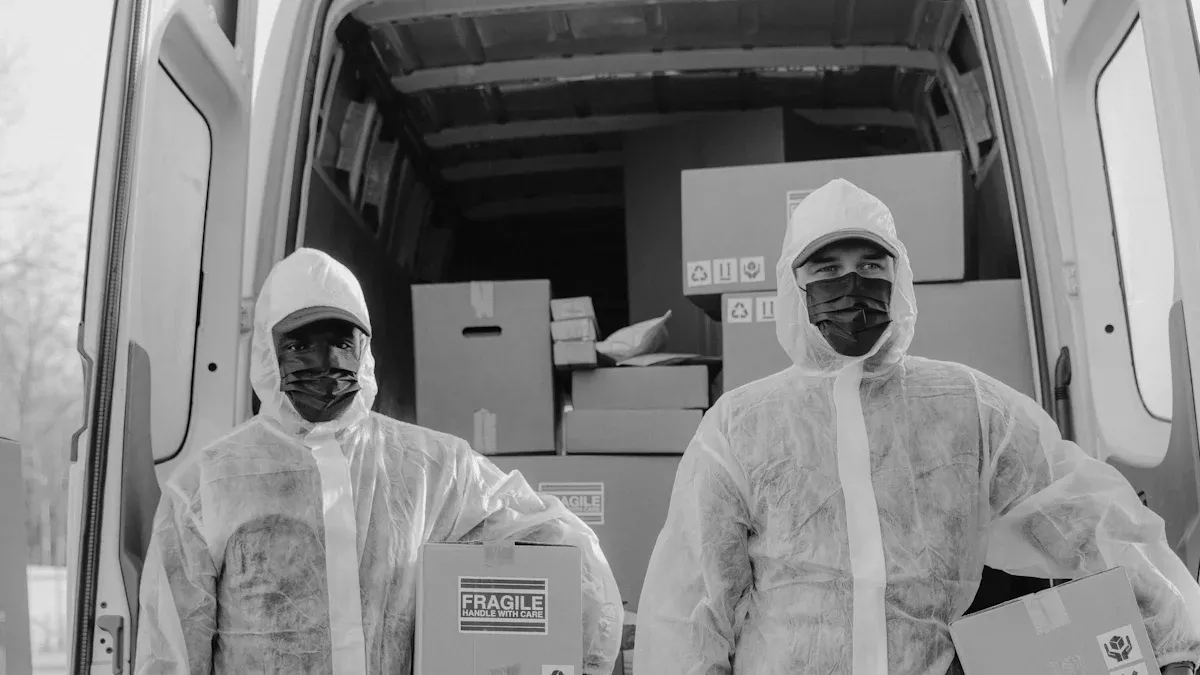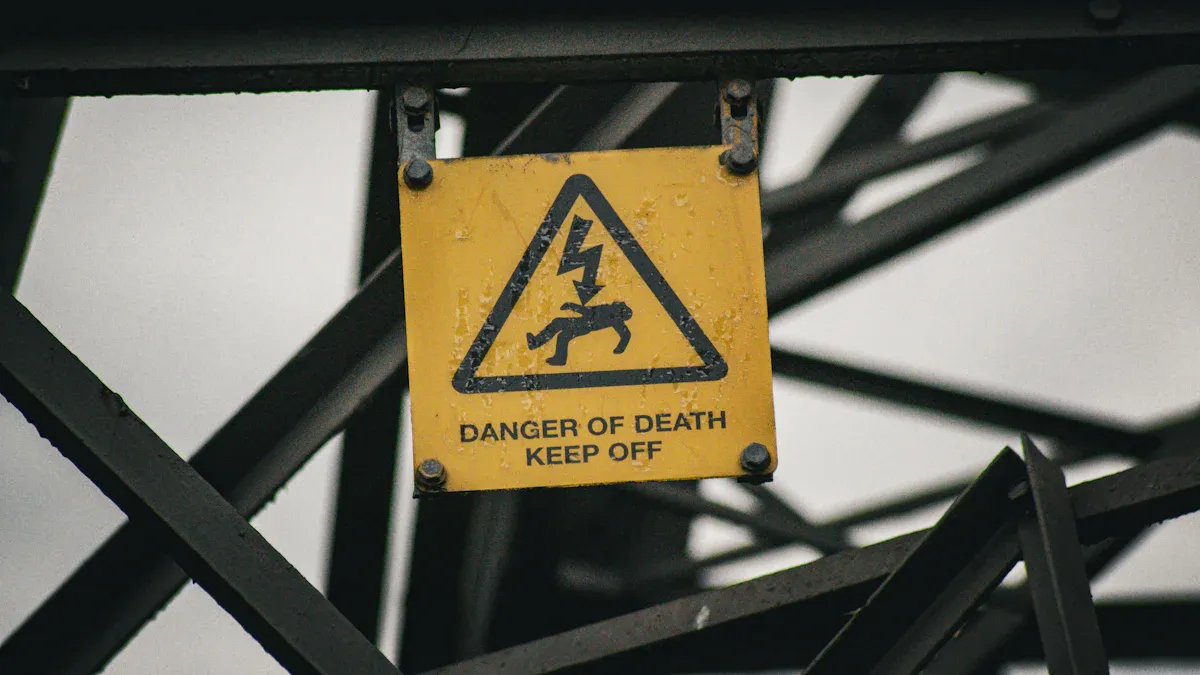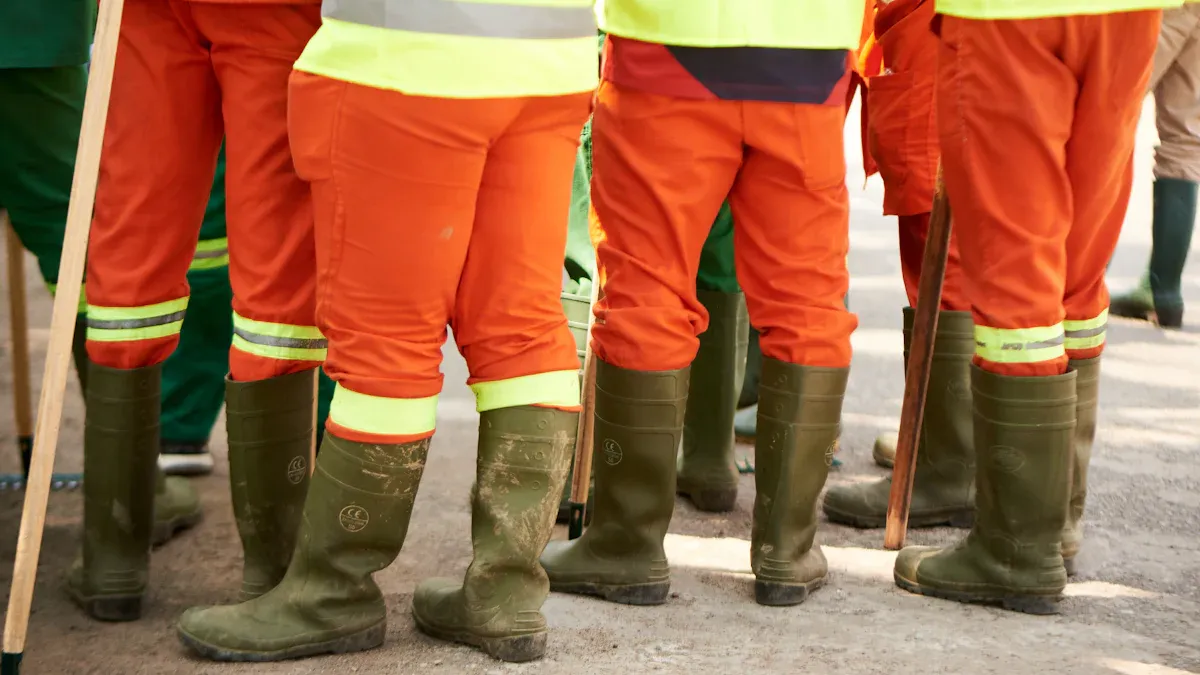How to Implement Safety Protocols for High-Risk Cargo Logistics

You face many dangers when managing high-risk cargo logistics safety protocols. Strong training and smart technology help you lower threats like cyber attacks. Industry standards give you clear rules to protect your cargo. When you build a safety-first culture, your team stays alert and ready to improve.
Cyber threats rise as systems become more digital.
Industry standards guide better security.
Key Takeaways
Train your team regularly to handle high-risk cargo safely. Strong training reduces accidents and keeps everyone alert.
Use technology like GPS tracking and IoT sensors to monitor cargo. These tools help you respond quickly to any issues.
Create clear standard operating procedures (SOPs) for every process. Good SOPs reduce confusion and ensure everyone knows their role.
Conduct regular audits of your safety protocols. Frequent checks help you find gaps and improve your processes.
Encourage open communication and reporting of safety issues. A culture of safety helps catch problems early and keeps your team engaged.
Risk Assessment

Risk Types
You face many risks when you handle high-risk cargo. Some risks come from outside your company, while others happen inside your operations. Here are some of the most common types you should watch for:
Cyber attack or data breach
Economic slowdown
Business interruption
Increasing competition
Regulatory or legislative changes
Supply chain or distribution failure
Property damage
Work injuries
Geopolitical volatility
Weather or natural disasters
You also need to consider operational risks, like delays or system breakdowns. Environmental risks, such as floods or hurricanes, can stop your shipments. Regulatory risks may lead to fines if you do not follow the rules. Cyber risks can disrupt your digital systems.
Risk Evaluation
You need to evaluate each risk to understand how it might affect your cargo. Start by setting clear goals for your risk management plan. Use expert opinions and scenario planning to identify possible problems. Technology helps you map risks and predict disruptions. You should:
Regularly update your risk assessment to keep up with changes.
Work with suppliers, customers, and your team to spot new risks.
Develop strategies to reduce risks, like using more than one supplier or tracking inventory with smart tools.
Tip: Review your risk assessment often. This helps you stay ready for new threats.
Prioritization
You cannot address every risk at once. You need to decide which risks matter most. Companies often use these criteria to set priorities:
Criteria | Description |
|---|---|
Financial impact | Looks at costs from disruptions, like lost sales or extra inventory. |
Impact on customer satisfaction | Checks how risks affect delivery times and order accuracy. |
Impact on business continuity | Focuses on risks that could stop your business, like transport issues or fires. |
Likelihood of the risk occurring | Measures how often a risk might happen. |
Cost of risk mitigation | Weighs the cost of fixing a risk against the benefit it brings. |
When you use high-risk cargo logistics safety protocols, you protect your business and keep your cargo safe.
High-Risk Cargo Logistics Safety Protocols
SOPs and Documentation
You need clear and detailed standard operating procedures (SOPs) to keep your team safe and your cargo secure. SOPs tell everyone what to do during loading, unloading, and transport. When you create these procedures, you help each person understand their role and reduce confusion. This step is vital for high-risk cargo logistics safety protocols.
Start by developing SOPs for every process, such as loading, unloading, and emergency response. Make sure you review and update these documents often. Good SOPs include steps like:
Inspecting cargo and containers before use.
Reviewing all documentation for accuracy.
Communicating with everyone involved in the shipment.
Tip: Use clear language in your SOPs so every team member can follow them easily.
You must also keep accurate records to meet regulatory requirements. The table below shows the main types of documentation you need for high-risk cargo logistics safety protocols:
Documentation Type | Description |
|---|---|
Classification | Proper classification of hazardous materials for compliance and safety. |
Identification Numbers | Unique numbers for tracking and safety. |
Emergency Contact Numbers | Quick access to emergency contacts for fast response. |
Handling Instructions | Clear steps for safe handling during transport. |
Packaging and Labeling Guidelines | Rules for choosing the right packaging and labels. |
Compliance Resources | References to PHMSA, OSHA, and other regulatory guidelines. |
Following these documentation practices helps you stay compliant with US DOT and industry standards.
Labeling and Packaging
Proper labeling and packaging protect your cargo and everyone who handles it. You must follow strict rules set by the US Department of Transportation. Labels must go on opposite sides of each package. For radioactive materials, you use specific labels like Radioactive White-I, Yellow-II, or Yellow-III. The transport index (TI) is also required for some labels.
When you use the right packaging, you lower the risk of damage and accidents. For example, excepted packagings are allowed for small amounts of radioactive material that pose a very low hazard. Using the correct box size can cut down on waste and reduce the chance of damage by up to 50%.
Here are some best practices for labeling and packaging:
Place clear labels to prevent confusion and mistakes.
Keep cargo organized with easy-to-read labels.
Use strong packaging to protect items from damage.
Train your staff on proper handling and lifting techniques.
Note: In 2023, the US reported at least 322 hazardous chemical incidents. Clear labeling and strong packaging help prevent these types of accidents.
When you follow these steps, you make high-risk cargo logistics safety protocols more effective and keep your team safe.
Equipment Checks
You must check your equipment before every shipment. This step helps you find problems early and avoid accidents. For high-risk cargo logistics safety protocols, equipment checks include:
Inspecting tires for proper inflation and wear.
Making sure lights and brakes work well.
Checking weight distribution.
Confirming tie-down points are secure.
You should also perform checks at set times during transport. The table below shows when to inspect your equipment:
Inspection Interval | Purpose |
|---|---|
Within the First 50 Miles of Travel | Tighten tie-downs, re-secure cargo, check securement devices. |
After Every Three Hours or 150 Miles | Confirm tie-down security, adjust cargo, check trailer for damage. |
At Every Duty Change | Verify cargo security during breaks or shift changes. |
Reminder: Regular equipment checks help you meet industry standards and keep your cargo safe.
By following these steps, you build strong high-risk cargo logistics safety protocols. You protect your cargo, your team, and your business.
Training and Competency

Training Programs
You need strong training programs to keep your team safe and ready. Good training gives your staff the skills to handle dangerous cargo and follow high-risk cargo logistics safety protocols. You should use practical lessons and interactive sessions. Instructors with real experience help your team learn faster. Course materials must follow the latest industry standards, like those from IATA. You can also create custom training for your company’s needs. When you update skills often, you stay in line with current rules.
Component | Description |
|---|---|
Practical and interactive training | Equips students with skills and knowledge to apply in the workplace. |
Highly qualified instructors | Experts in their field with a proven ability to deliver courses effectively. |
Course materials | Based on IATA’s manuals, standards, and industry best practices. |
In-house customized training | Tailored to specific learning objectives of the organization. |
Up-to-date skills | Courses based on the latest IATA Manuals, ensuring compliance with current rules and regulations. |
Tip: Use hands-on training and real-life scenarios to help your team remember safety steps.
Ongoing Education
You must keep learning to stay safe in high-risk cargo logistics. Ongoing education helps your team spot problems and react quickly. Regular training teaches your staff how to notice suspicious actions and prevent theft. Drivers learn to stay alert and protect cargo. Studies show that ongoing education lowers the number of incidents and keeps your supply chain secure.
Evidence Source | Key Findings |
|---|---|
Cargo Theft in America: The Rising Threat to Supply Chain Security | Ongoing training ensures team members know how to recognize and respond to suspicious behavior, enhancing security measures in the supply chain. |
Understanding Cargo Theft Trends and How to Prevent It | Comprehensive driver training programs emphasize vigilance and theft prevention. |
Note: When you invest in ongoing education, you build a safer workplace and reduce risks.
Evaluation
You need to check how well your training works. Use tests and quizzes to measure what your team knows. Watch your staff during real tasks to see if they follow safety steps. Ask for feedback to find areas to improve. You should review training results often and update your programs as needed. This helps you keep your high-risk cargo logistics safety protocols strong and effective.
Give regular assessments to track progress.
Use feedback to improve future training.
Update training materials to match new rules.
Reminder: Strong evaluation keeps your team ready for any challenge.
Technology and Security
Monitoring Tools
You can use advanced technology to keep your high-risk cargo safe. GPS tracking lets you see where your cargo is at all times. If your shipment leaves its planned route, you get an alert right away. Sensors can tell you if someone tries to open a container in the wrong place. These tools help you act fast if something goes wrong.
Many companies use these monitoring tools:
IoT-enabled sensors give you real-time data about your cargo’s location and condition.
GPS tracking shows you where your cargo is during the whole trip.
Real-time monitoring systems watch your cargo 24/7 and send alerts if anything unusual happens.
Technology Type | Description |
|---|---|
IoT-enabled sensors | Devices that provide real-time data on cargo conditions and location. |
GPS tracking | Allows for continuous location tracking of cargo during transit. |
Real-time monitoring systems | Systems that provide 24/7 visibility and alerts for any anomalies in cargo conditions. |
Tip: Set up geofencing to create virtual boundaries. If your vehicle leaves this area, you get an instant alert. This helps you stop theft before it happens.
Layered Security
You need more than one layer of protection to keep your cargo secure. Start with strong locks and barriers. Add electronic surveillance like cameras and sensors. Use strict rules for who can access your cargo. Train your team to follow these rules every time.
A good layered security plan includes:
Regular risk checks and updates to your security plan.
Physical security, such as high-grade locks, which can cut theft by up to 89%.
Technology that gives you real-time data and alerts.
Well-trained staff who know how to spot and stop threats.
Set up a 24/7 monitoring center to watch for problems. If something happens, your system should send automatic alerts to your team and law enforcement. Keep in touch with your drivers and customers during any incident. Use an emergency playbook to guide your response and keep tracking active until you recover your cargo.
Note: Combining technology, strong policies, and trained people gives you the best chance to protect your high-risk cargo.
Safety Culture and Compliance
Communication
You build a strong safety culture when you communicate clearly with your team. Everyone needs to know their roles and responsibilities. When you share information openly, you help your team avoid mistakes and work together better. You also make sure everyone can make smart decisions quickly.
Clear communication helps your team understand their tasks.
Good collaboration improves how you move cargo.
Sharing information openly lets everyone react fast to problems.
Leadership sets the tone for safety. When leaders talk about safety often, your team feels safe to report risks. Ongoing safety training keeps everyone alert and ready to act.
Reporting
You need a system for reporting safety issues and incidents. When your team feels safe to speak up, you catch problems early. Staff members report irregularities when they know their input matters and they will not get punished. You should encourage everyone to share concerns, even small ones. This helps you fix issues before they grow.
Description | |
|---|---|
Reduced Insider Threats | Employees protect assets, so you see fewer internal security breaches. |
Improved Incident Reporting | Staff report problems more often, knowing their voices count. |
Enhanced Compliance | Your team follows rules naturally, so you see fewer violations. |
Better Crisis Response | Quick reporting leads to fast and organized action during disruptions. |
Audits
You must check your safety protocols often. Audits help you find gaps and improve your processes. You review records, inspect vehicles, and check if your team follows the rules. Regular audits keep you in line with US DOT regulations. You need to monitor drivers’ hours, maintain vehicles, and use proper identification numbers.
Key Requirements | |
|---|---|
Oversized and Overweight Loads | Get permits, use escorts, and follow federal size and weight limits. |
Hazardous Materials | Follow the Hazardous Materials Transportation Act for classification and packaging. |
Driver Fatigue Management | Track working hours to prevent fatigue. |
Vehicle Maintenance | Inspect and maintain vehicles regularly. |
Continuous improvement keeps your safety culture strong. When you audit and update your protocols, you protect your cargo and your team.
You improve safety for high-risk cargo by following clear steps. You train your team, use technology, and check compliance often. You face challenges like regulatory rules and the need for proper training.
Challenge | Implication |
|---|---|
Regulatory compliance | Fines and delays |
Need for proper training | Higher risk of accidents |
Non-compliance | Loss of trust and business |
You measure success by using chain-of-custody protocols and real-time tracking. You encourage regular audits, feedback, and a safety-first culture. Keep reviewing your safety measures and reward safe practices. Stay proactive and make safety your top priority.
FAQ
What is high-risk cargo?
High-risk cargo includes hazardous materials, oversized loads, and valuable goods. You must follow strict safety rules when you move these items. These rules help you protect people, property, and the environment.
How often should you update safety protocols?
You should review and update safety protocols at least once a year. You also need to update them after any incident or when regulations change. Regular updates keep your team safe and your business compliant.
Why is training important for high-risk cargo logistics?
Training teaches your team how to handle dangerous cargo safely. You learn how to spot risks, follow procedures, and respond to emergencies. Good training lowers accidents and keeps your cargo secure.
What technology helps you monitor high-risk cargo?
You can use GPS tracking, IoT sensors, and real-time monitoring systems. These tools show you where your cargo is and alert you to problems. Technology helps you act fast and prevent theft or loss.
How do you report a safety incident?
You should use your company’s reporting system. Fill out an incident form and tell your supervisor right away. Quick reporting helps you fix problems and improve safety for future shipments.
See Also
Key Strategies for Effective Global Logistics Operations
Count on PGL for Secure HAZMAT Freight Solutions
Crucial LCL Shipping Guidelines for Panama Exports by PGL
Streamlined Inventory Management and Distribution with PGL Warehousing
